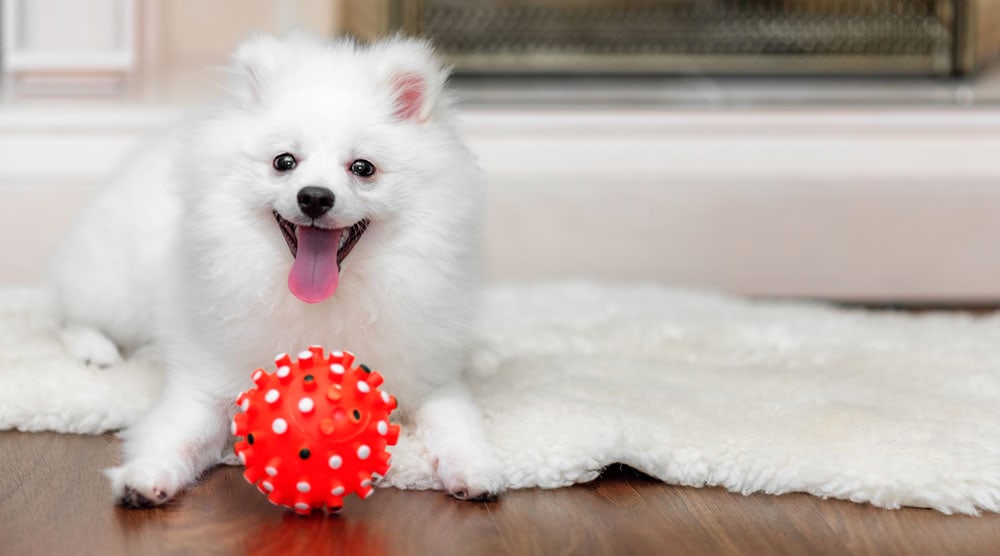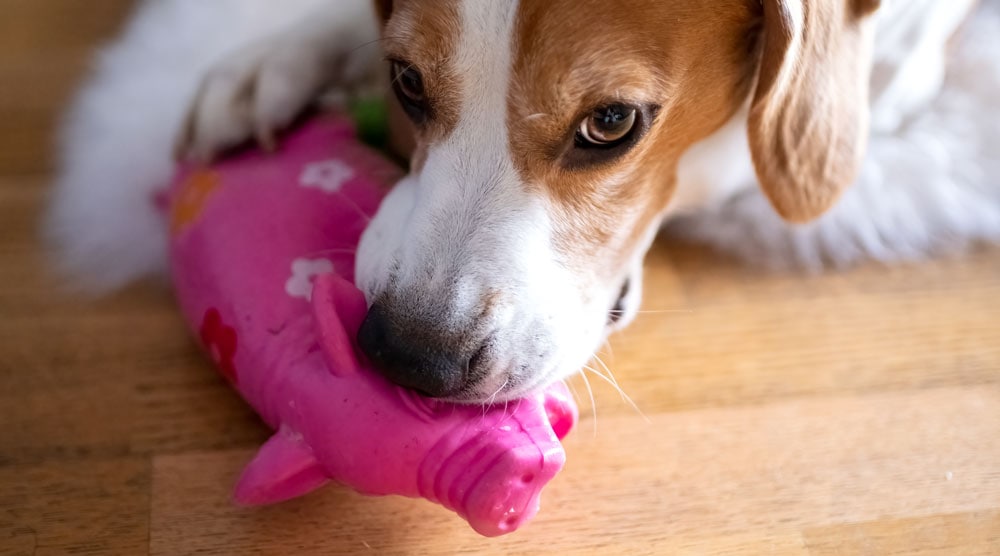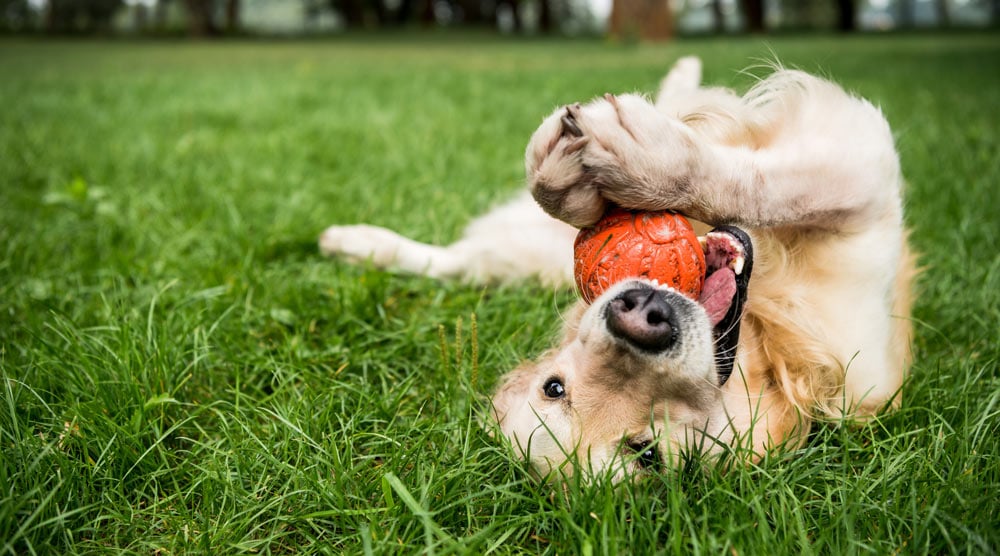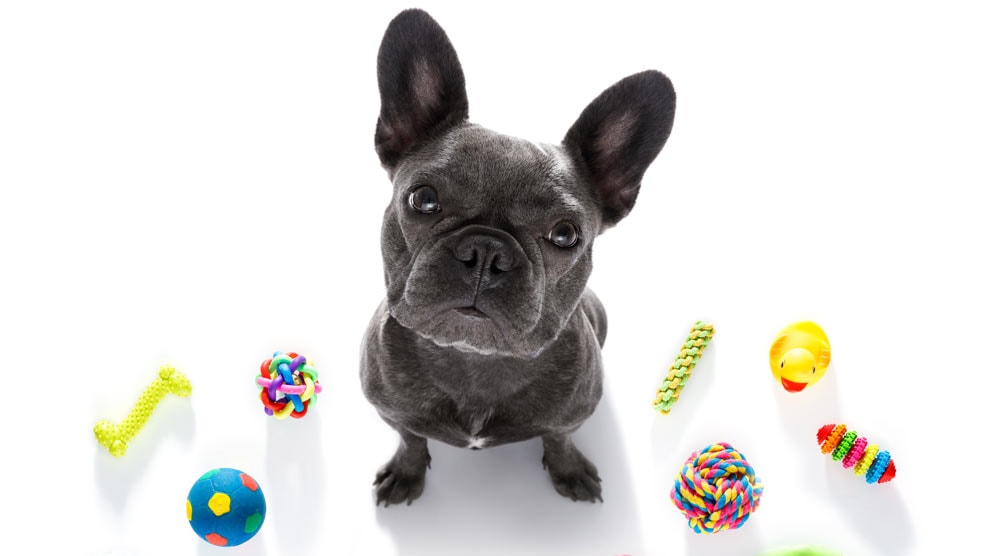These 24 indoor activities for dogs are great for additional enrichment. They shouldn’t replace walks, but can keep your dog entertained – especially when outdoor time is restricted due to bad weather, health problems, or age.
Contents
- 24 of the Best Indoor Games for Dogs
- 1. Trick Training Using Positive Reinforcement
- 2. Interactive Food Toys
- 3. Which Hand?
- 4. Snuffle Mats
- 5. Tug-Of-War
- 6. The Cup Game
- 7. Flirt Poles
- 8. Treat Hunts
- 9. Teach Your Dog to Put His Toy’s Away
- 10. Teach Toy Names
- 11. Hide and Seek
- 12. Grooming
- 13. Play Tag
- 14. Bring Out High-Value Toys
- 15. Reinforce Basic Obedience Commands
- 16. Indoor Obstacle Courses
- 17. Make Cardboard Toys
- 18. Relax on the Couch
- 19. Pup Play Dates
- 20. Indoor Fetch
- 21. Pup Photography Sessions
- 22. The Muffin Tray Game
- 23. Practice Clicker Training
- 24. Take a Training Class
- Summary
Indoor activities can provide vital enrichment when your dog can’t spend enough time outside. Whether extreme weather conditions are curtailing your usual long walks, or your pet’s exercise is restricted due to injury, age or surgery, indoor games can help.
Here are 24 of my favourite indoor activities you can perform in any weather. I’ve focused on games where you are involved, as this builds a strong bond – plus your dog will have a lot more fun!
Note: We’ve also written a separate guide to fun outdoor activities to do with your dog.
24 of the Best Indoor Games for Dogs
1. Trick Training Using Positive Reinforcement
Why not teach your dog a new trick on a rainy day? Picking a simple trick, like ‘shake hands’ or ‘spin,’ can be a great place to start. If you both enjoy training, you can move onto something more challenging like ‘rollover’, ‘play dead’ or ‘sit pretty.’
All dog training should focus on positive reinforcement. In simple terms, every time your dog does something that you want, they get a super yummy treat. It’s all about timing, building things up in small steps, keeping the sessions short, and ending on a high note.
If you’re looking for inspiration, check out the Kikopup YouTube channel. Emily Larlham has a series of in-depth dog training tutorials, including a fantastic set of trick training options, featuring her gang of wonderful dogs.
2. Interactive Food Toys
For those times when you can’t play with your dog directly, interactive treat toys can be a great option. They encourage your dog to use their natural skills in foraging, nose work and problem-solving. A bonus is that food toys slow down your dog’s eating – which is useful if your pet usually gulps down his dinner!
Be sure to pick something that’s size appropriate and tough – especially if you’re leaving your dog unsupervised. Avoid complex toys to begin with, as these can cause frustration.
We’ve written an article about the best food toys, which you can read here. A few of our top picks include:
- Kong Wobbler (or just a regular stuffed Kong)
- PAW5 Wooly Snuffle Mat
- Trixie Flip Board
If your dog eats too quickly but isn’t confident using puzzle toys, you may also want to try a slow feeder.
Tip: Non-food toys are also essential for keeping your dog entertained. Click here for our list of the best dog toys.
3. Which Hand?
The “Which Hand?” trick harnesses your dog’s natural scenting abilities. The idea is that your dog should signal which hand contains the treat – and get a reward when correct.
Pick something delicious, small and smelly when you first introduce the game. Show both fists, then give the reward when they show interest in the correct hand.
If they select the wrong fist, open the hand to show there is nothing there. The dog only gets the reward when they paw, touch, point or bark at the correct fist.
Once your dog is reliably scenting out the correct fist and giving you the desired indicator, you can make it more challenging by adding fists from more family members.
4. Snuffle Mats
Did you know studies have shown that dogs who get increased opportunities to sniff are more “optimistic” when faced with new tasks?
Snuffle mats are a great option for encouraging your dog to use their nose. They are typically small mats with interwoven pieces of material that are designed to mimic grass. The pieces of food can be hidden amongst the ‘grass’ for your dog to find. Some also have treat pockets.
Snuffle mats can be useful for dogs that haven’t got the hang of more complicated puzzle toys yet. They aren’t chew proof though, so should only be used with supervision.
5. Tug-Of-War
A 2003 study suggested that playing tug can help dogs feel more confident and that it encourages a bond of trust between the owner and their dog. It also showed that playing “tug” doesn’t make your dog more dominant or aggressive.
If you have an easily over-aroused dog, playing tug politely can be a great way to teach impulse control. Always wait for calm behavior before initiating the game and reward whenever they release the toy on cue (you’ll need to teach “give” first.)
Make sure you pick an appropriately sized toy to avoid accidental nipping and a potential choking hazard. It’s also a good idea to have a specific toy for tug of war that isn’t available to your dog at other times.
Always shake the toy from side to side rather than up and down. Also, keep the sessions controlled and short to prevent any accidental strain or injuries. Be particularly careful when playing this game with a puppy.
6. The Cup Game
Once your dog has mastered the ‘Which Hand?’ game, you can introduce the same premise but with cups. Use one cup initially and teach your dog to find the treat, then move onto two and three for an extra challenge.
When your pet is reliably finding the treat, you can even start slowly shuffling the cups and see if they can follow the treat. This game is a great way to test their problem-solving ability – plus the attention required can be very tiring for a dog!
This video shows how to teach your dog a “cheating” version of this trick – but it’s still a fun game to play with your pup.
7. Flirt Poles
A flirt pole looks a bit like an oversized cat toy, with a toy attached via a rope. This acts as a lure for your dog. It’s a wonderful way to give your dog indoor exercise – although you’ll need to teach a strong release command before you use one.
Start by encouraging your dog to chase the lure. When he catches the toy, give the “release” command followed by a tasty treat.
This is a fun game that combines training with physical exercise, so it can tire out dogs pretty quickly. Like a game of tug, it can also teach impulse control and coordination.
Sessions with a flirt pole should always short and supervised, and the lure shouldn’t be too heavy. It isn’t designed as a tug toy, but instead should be released on cue in anticipation of a reward and a further game.
Make sure you only play with a flirt pole on a non-slip surface, like a carpet or a rug. Slipping can cause a painful injury to your dog.
8. Treat Hunts
Playing a game of treasure hunt is another way to harness your dog’s sense of smell. You can use high-value treats or kibble, or, if you want to watch their waistline and they are very toy motivated, you could hide their favourite toys instead.
Make sure your dog doesn’t see where you are hiding the treats. You may need to pop them in another room while you do this. Once the treats are all hidden, bring your dog back in and allow them to search.
You might need to point your dog in the right direction until they get the hang of the game. Once they are reliably finding the treats, you can start to introduce a verbal cue, such as ‘find’, or ‘seek.’
Make sure you put the treats in safe-to-reach places and not hidden where your dog has to work too hard to get them out. This is an activity that’s always best supervised, as some dogs may get over excited and start trying to take apart furniture to get to a treat!
9. Teach Your Dog to Put His Toy’s Away
If your dog already knows cues for ‘take it’ and ‘drop it’, then you could up the ante and get them to tidy away their toys.
Use a specific basket for this task and have it positioned very close to your dog. Ask them to take a toy. Once they have picked it up, lure their head over the basket and ask for “drop.”
When it lands in the basket, reward them with a tasty treat. Repeat this several times, before beginning again with the basket moved slightly further away. You may need to lure them towards the basket with the treat initially.
Once they are reliably dropping the toy in the basket, you can use a verbal cue like ‘tidy’ to go along with it. Lots of repetition and reward will be required to make this one a success, so don’t move onto the next step too quickly.
10. Teach Toy Names
If you’ve ever seen Chaser, the famous Border Collie, you’ll know it’s possible to teach a dog the names of their toys. Chaser knew the names of over 1,000 individual toys!
This is a game that needs to be built up in stages slowly.
- Start by picking your dog’s favourite toy and ask them to pick it up, calling it by a specific name (if you called it ‘ball’ before, stick with that). Every time they pick it up, they get a treat.
- Next, put a couple of other items down beside the ball, but choose things that are not likely to get your dog excited. Whenever they pick up the correct item (the “ball” in our example), give more treats and praise.
- Now, to make it more challenging, add a different toy and only reward your dog if they bring back the ball.
- Over time, you can start to repeat this process with a different toy and name.
- When your dog knows two toy names, start putting them together and only rewarding when they retrieve the one you requested.
- Once they are reliably differentiating between the two toys, you can add a third toy into the mix.
The great thing about this game is that it can always be made more difficult as your dog learns. And if you need some inspiration, here’s a video showing what Chaser could do.
11. Hide and Seek
“Hide and Seek” is a fun indoor game that many dogs love. It can also strengthen your bond and even improve your pet’s recall.
If your dog has a good ‘wait’ command, get them to wait while you hide, then call them from your hiding place. If not, you may need to get a friend or family member to distract them in a different room.
Once your pet finds you, give lots of praise and a tasty treat.
Don’t start with too tricky a hiding place – you don’t want to cause frustration! You can also offer a little help or encouragement if they are struggling.
12. Grooming
This may seem like an unusual choice! But introducing a regular grooming schedule, even if you have a short-haired dog, can be a great bonding experience. It can also help your pet to relax during physical contact.
Working on positive associations will also mean they are less likely to be stressed when visiting a groomer or vet.
Always start slowly. Make sure your dog is comfortable with you touching certain parts of their body, like their ears and paws. Give plenty of rewards and praise after each touch to encourage positive associations.
When you introduce a grooming tool, such as a nail grinder, don’t use it on your dog straight away. Allow your dog to approach it themselves and offer a treat when they engage with it. When you start to use it, if they seem nervous, build up slowly with light touch alongside praise and reward.
Never force your dog if they are uncomfortable. Be patient and go back a step and take things more slowly.
Once your dog is relaxed during your grooming sessions, ask other family members or friends to be involved in the process. This means that if they are at the vet or groomers, they will be less likely to be intimidated by the introduction of a new person.
13. Play Tag
You’ll need two people for this game – but it can be a lot of fun!
One person should stand at the opposite end of the room and call the dog. When they come, reward with praise and a yummy treat. The other person should then call the dog and also praise and reward.
Start close to one another and increase the distance over time. Eventually, one person can be upstairs and the other in the farthest away downstairs room. Not only does this game develop a great recall, but it is fun and tiring for your dog.
14. Bring Out High-Value Toys
It’s a good idea to rotate your dog’s toys to help keep them stimulated and engaged.
Studies show that dogs are neophiles, which means they love new and novel things. By only bringing a toy out at certain times, it remains “new” for much longer.
15. Reinforce Basic Obedience Commands
Sometimes it’s easy to overlook basic commands. Without regular practice, these can get a little rusty.
Why not spend a rainy day perfecting these handy essentials? Not only can basic obedience training mentally tire your dog, but you’ll also have more trust in his response when you really need it.
You can also increase the difficulty of commands your dog already knows. If they already offer a good stay, for example, practice at further distances or with more distractions in the environment.
16. Indoor Obstacle Courses
Even if your dog has never tried an agility class, you can create a fun little course in your home. This can build confidence, work on balance and body awareness and, above all, it can be great fun for your dog.
Get creative! Maybe you can form a tunnel with a blanket secured over some chairs, or use a hula hoop or rolled-up blanket as a jump, or even a sturdy box as a pause table.
Just make sure that whatever you use is secure and that you are not using it on slippery surfaces. Always introduce your dog to new obstacles slowly, encourage them with treats and never force them to try things they are not comfortable with.
This video gives a few good examples:
17. Make Cardboard Toys
Toys from cardboard can be a source of endless fun and entertainment for your dog. A simple example is hiding kibble in an old cereal box, toilet roll inner or egg box. Many dogs will have lots of fun throwing or tearing the cardboard to access the treat.
Larger boxes can also be a fun way to “free-shape” some behaviors. Free shaping involves encouraging your dog to choose a behaviour on his own, rather than waiting for a command. It can be a lot of fun and endlessly stimulating for a dog.
The best way to learn this technique is by reading the article ‘101 things to do with a box’, which is written by renowned behaviourist Karen Pryor. You’ll need a clicker and lots of treats – and you might be surprised by what your dog ends up doing. Often it can lead to the dog hiding inside the box, or using it to cover themselves completely!
18. Relax on the Couch
Too much activity and adrenaline can release cortisol, which is stress-inducing and can make it difficult for your dog to relax fully. For this reason, it’s important to look out for signs that your dog is being over-aroused.
Making sure your dog takes time out to settle, especially if they are high-energy, can also be good for them. Spending time together on the couch – even if you’re watching TV – is often a dog’s favourite way to relax.
While some dogs want affection, be respectful of your dog’s space too. Some might just want some quiet alone time, and others might not enjoy being hugged and restrained. Learning to understand their body language is important.
19. Pup Play Dates
If your dog enjoys the company of other dogs, and they already have doggy friends, a pup play date could provide enrichment during bad weather conditions.
Always remember to be sensible with in-house introductions though. Many dogs are territorial in their own space, so it’s best to introduce two dogs in a neutral space. Constant supervision and observing body language is also needed.
This activity isn’t suitable for all dogs. If your dog isn’t comfortable around other dogs, or hasn’t met a particular dog before, don’t force them into the same space together.
20. Indoor Fetch
Fetch doesn’t need to be limited to outdoors – as long as you have enough space. Chuckit, for example, has a range of soft balls designed for indoor play.
Be sensible though. If your dog has to squeeze through a cramped environment, then fetch isn’t a good idea. You don’t want them to get injured or cause any damage around the house. Fetch should also only be played on carpets or rugs to prevent slipping.
Keep the sessions short and don’t let the play get too out of control.
21. Pup Photography Sessions
Getting some sweet photos of your dog can be great for your social media accounts, but it can also be a fun training session for your pup. Practice basic commands like “sit” and “stay” before snapping some cute shots, making sure to give plenty of rewards.
If your dog knows more advanced commands, such as “sit pretty” or “wave,” these can also make wonderful poses.
Of course, don’t get frustrated if your dog isn’t the perfect canine model. Ultimately, this activity is for your dog’s benefit, so be patient and keep the sessions fun and short.
22. The Muffin Tray Game
If you want to create an interactive treat game without spending money on a puzzle feeder, the muffin game could be a great alternative.
Put a yummy treat or piece of kibble in the tray’s holders, and then cover them with balls.
Your dog then needs to work on getting the ball out to find the treat. Once they have the hang of it, you can make it more of a challenge by only putting treats under some of the balls.
23. Practice Clicker Training
A clicker is a little hand-held training tool that makes a sound when you press it. This sound is used to mark desired behavior when your dog offers it. Immediately after the clicker sound, your dog gets a tasty reward.
It is a simple, effective and gentle method of training. It can also be a great way of teaching complex behaviors, as you can break it down into smaller, more manageable chunks for your dog using a technique called Shaping, as explained here in more detail by Karen Pryor.
Watch this video of Maui the Husky learning to pick up his collar through clicker training for a great visual example:
A lot of people teach their dog to ‘beg’ or ‘sit pretty’ using this technique. You start by mastering sit, and then you move on to having them lift one paw, then two paws with support, before removing the support. Any of the fun tricks we mentioned at the top of the article could be taught using clicker training.
24. Take a Training Class
If you’re both going stir crazy indoors, or are looking for some additional training tips and guidance, then why not consider enrolling in a local indoor dog training class?
Make sure to select a trainer who is fully qualified and accredited. We also recommend only looking for trainers who exclusively use scientific, positive and force-free training techniques (this should be mentioned on their website.)
It doesn’t just have to be an obedience class either. Maybe you would like to get involved with nose work trials or try canine freestyle doggy dancing.
If you have a dog that’s not keen on being in an enclosed space with other dogs, you could look for a “reactive rovers” class, or speak to the instructor in advance. Some classes are set up to ensure every dog has enough space to feel comfortable.
If they are very reactive, then you could consider having some 1-2-1 sessions instead.
Summary
Indoor games aren’t designed to replace the daily walks and physical exercise that your dog needs. All canine companions need outdoor time!
They are a great option for extreme weather though, when a long walk wouldn’t be safe. Indoor games can also be used alongside outdoor exercise to keep your dog mentally and physically enriched.
Best of all, many of these games can forge a stronger bond between you and your dog.
Do you have a question about any of the indoor activities for dogs in this article? Or do you have another indoor game that your dog enjoys? Let me know in the comments section below!




